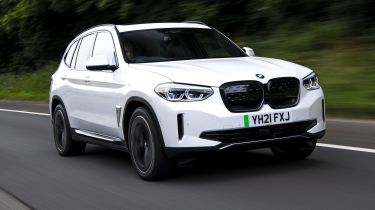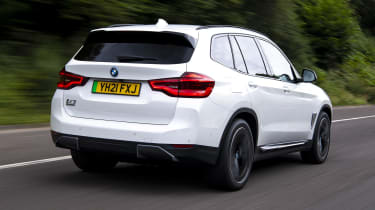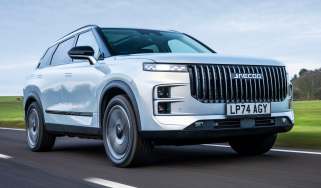BMW iX3 SUV review
The BMW iX3 is an electric variant of the popular X3 SUV, with over 280 miles of range
Pros
- Range
- Refinement
- Practicality
Cons
- Firm ride
- Faster rivals
- Unadventurous design
While BMW wowed the automotive world with its i3 electric hatchback and i8 plug-in hybrid coupe almost a decade ago, the all-electric BMW iX3 SUV is altogether a more staid proposition. Unlike the flagship BMW iX electric SUV, the iX3 is an electric version of a car BMW already sells, namely, the BMW X3.
 Top 10 best electric SUVs – the ones to buy in 2025
Top 10 best electric SUVs – the ones to buy in 2025
There's been a deliberate decision not to go radical with the design, with BMW instead opting to add aerodynamic wheels, blue trim accents and a smoothed-off grille to a familiar package. There's also a new set of bumpers and side skirts, all tested in the wind tunnel to ensure they are slippery enough to help maximise the driving range. This is really just an X3 for buyers who want an electric version but don't want to shout too loudly about it.
Under the car's floor is an 80kWh battery that sends its power to a rear-mounted 282bhp electric motor and only the rear wheels. This is a departure from rivals like the Audi e-tron, Jaguar I-Pace and Mercedes EQC, which all have two motors, four-wheel-drive and quite a bit more power. While it isn't as fast as those cars, the iX3's 285-mile range is competitive, beating both its German rivals and just slightly behind the I-Pace. In real-world conditions, the iX3 is likely to be even closer to the Jaguar, which struggles to hit its official figures
in our experience.
More reviews
In-depth reviews
The iX3 can also be charged quickly, obtaining speeds of up to 150kW at the latest rapid-charging stations. Of its closest rivals, only the e-tron can match this, with the others topping out at around 100kW, and it means the iX3 battery can be replenished to 80% in a speedy 27 minutes. Thanks to this capability, making one stop on a long journey should be ample to get drivers to their destination with range to spare.
Like the exterior, the inside of the iX3 is very much a mild variation on the X3, with some flashes of blue trim to show this is the electric version. It shares the same 10.25-inch iDrive infotainment display perched above the dashboard and a 12.3-inch digital instrument screen. Premier Edition and Premier Edition Pro trims serve up plenty of equipment, with features like a head-up display, a Harman Kardon stereo and wireless phone charging in the top trim.
Premier Edition and Premier Edition Pro trims were offered at launch but an early facelift not long after the iX3 went on sale replaced them with M Sport and M Sport Pro. Both serve up plenty of equipment, with features like a head-up display, a Harman Kardon stereo and 20-inch aerodynamic alloy wheels in the top trim.
With a battery positioned under the floor, the iX3 is also a practical family car, offering spacious seating for up to five adults and a 510-litre boot. Fold down the back seats and this increases to 1,560 litres, making the iX3 a decent load-lugger - although it can only tow 750kg.
The BMW iX3 is spacious, quiet and has a good range, but it's a shame it doesn't feel anywhere near as special as the i3 and i8. Instead, along with the i4 and iX, it ushers in an era in which electric BMWs will be a more mass-market part of the lineup, designed to help owners make the switch away from petrol and diesel.
One sticking point if you're planning to make the switch from a regular X3 to an iX3 is the difference in price, with the electric model costing around 20% more; this has an effect on monthly PCP payments. An extensive standard equipment list and the benefit of a zero-emission powertrain does help justify the additional cost.
The iX3 is unlikely to disappoint you if your budget can stretch to it; it's good to drive, practical and has a very comfortable, upmarket interior. However, our Driver Power survey suggests BMW buyers haven’t found the ownership experience hugely satisfying, with the German brand finishing in the bottom third of the manufacturer rankings.


















